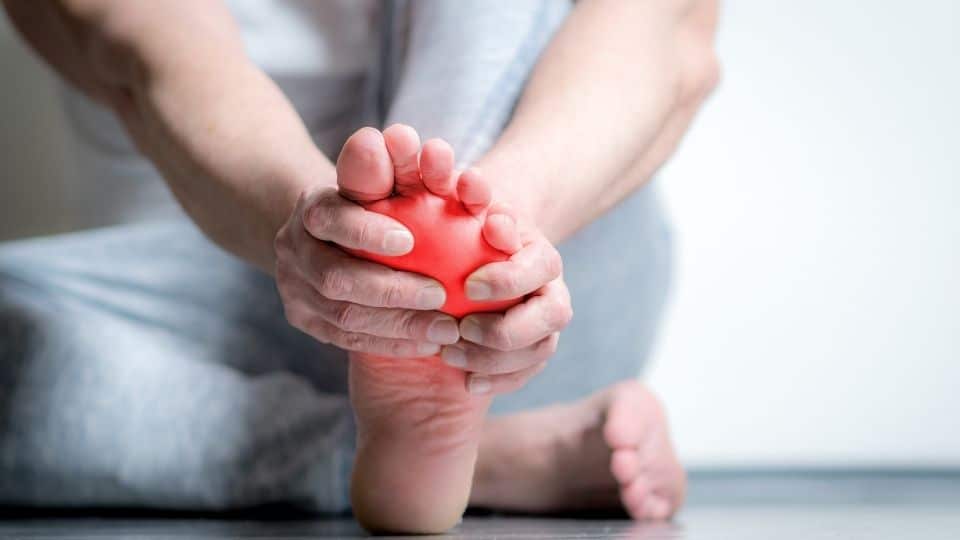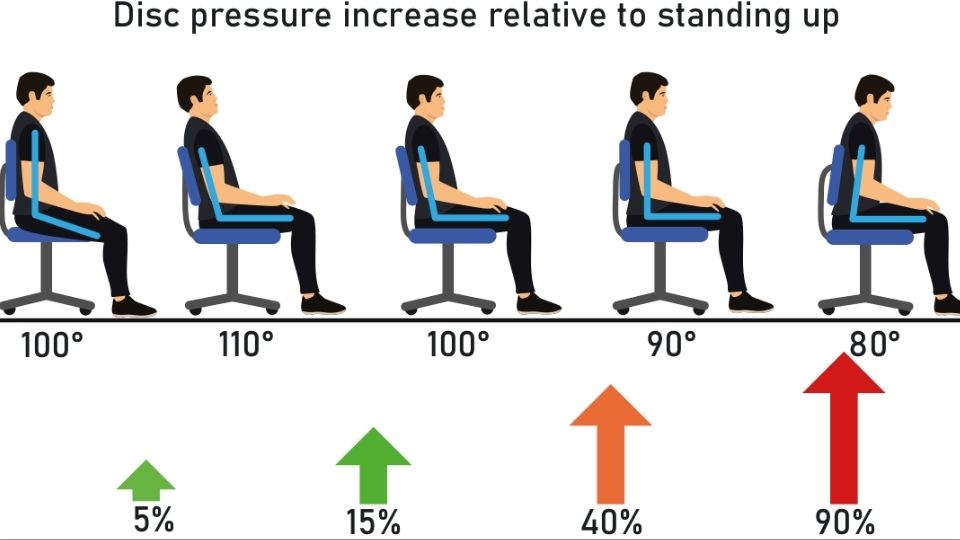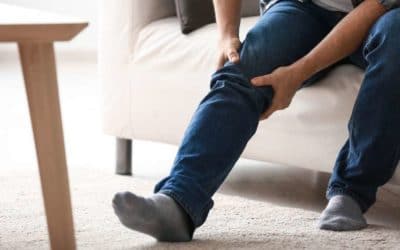If you have plantar fasciitis, you know how painful it can be to walk or stand. You may wonder how you should sit with plantar fasciitis. Sitting in the proper position can help to relieve some of the pain. Here are a few tips on how to sit correctly with plantar fasciitis.
As a general rule, the best way to sit if you have plantar fasciitis is to sit upright with both feet on the ground. This way, your hips will be 3-4 inches higher than your knees, and you will be releasing pressure from your spine. This can help prevent pain in your spine, legs, and feet.
I can help you with how to sit if you have plantar fasciitis. I have helped people with this problem for 30 years, and I have also researched it. I made a youtube video about this subject, and I even wrote a book about common back, leg, and foot problems.
How to Reduce Plantar Fasciitis Pain When Sitting
If you are experiencing plantar fasciitis, it is essential to follow some basic recommendations to prevent the condition from worsening. First, it is crucial to get up and move every 20 minutes to avoid stiffness and keep the muscles in your feet loose. Additionally, lumbar support is essential to maintain correct posture and alignment.
When sitting, be sure that your feet are flat on the ground and I believe that your hips are at a height above your knees. You may also want to try increasing the width of your chair, as this can provide additional support. Ergonomic chairs are often adjustable in-depth, so be sure that the knees of a person seated cannot be closer to the edge of the seat than three fingers.
Best Seat Cushion for Plantar Fasciitis
Many people don’t realize the importance of proper chair cushions. A good ergonomic seat cushion can enhance your sitting experience by providing comfort and support. When considering different materials, natural latex is known to be a popular option for its durability, density, and support. It is often paired with a softer layer on top for added comfort. It is important to find a cushion that meets your needs and preferences.
I explain what is the best seat cushion on a TV show HERE.

Having a non-slip cover and base is also essential, so you can sit upright for a long time without your cushion sliding around. Furthermore, high-end seat cushions typically prevent painful pressure points in the buttocks by keeping pressure away from sensitive parts, such as hips, tailbones, and thighs. With a proper seat cushion, you’ll be able to stay comfortable all day long.
I was surprised how similar cheap memory foam seat cushions were on Aliexpress from the listing on Amazon!
Is It Better to Stand or Sit With Plantar Fasciitis?
As a general rule, research has shown that a combination of sitting, standing, and moving is more effective. Moving around helps to stretch the plantar fascia and ease heel pain. In addition, it is essential to maintain good posture and wear supportive shoes.
Plantar fasciitis is a condition that can cause heel pain. Although various treatments are available, there is no definitive cure. For this reason, many people with plantar fasciitis are looking for ways to manage their pain and prevent the condition from worsening. Some believe standing is the best way to keep plantar fasciitis from progressing. By following these simple tips, you can help to keep plantar fasciitis pain under control and prevent the condition from worsening:
1. Wear supportive shoes. Shoes that are too big or too small can strain the plantar fascia unnecessarily, leading to pain. Wearing shoes with good arch support can help take some pressure off the plantar fascia and reduce heel pain.
2. Maintain good posture. Poor posture can strain the plantar fascia and cause heel pain. Make sure to stand up straight and avoid slouching.
3. Move around. Sitting or standing in one position for too long can worsen plantar fasciitis. Move around every few minutes to keep the plantar fascia stretched and relieve heel pain.
4. Stretch the plantar fascia. Stretching the plantar fascia can help to ease heel pain and prevent the condition from worsening. Try a simple stretching exercise like rolling a tennis ball under your foot for 30 seconds.
5. Apply ice to the heel. Ice can help to reduce inflammation and pain. Try applying ice for 10-15 minutes several times a day.
These simple tips can help ease plantar fasciitis pain and prevent the condition from worsening. Remember, a combination of standing, sitting, and moving is usually the best way to manage plantar fasciitis. And be sure to wear supportive shoes and maintain good posture to help reduce strain on the plantar fascia.

Does Sitting Aggravate Plantar Fasciitis?
Sitting down may aggravate your plantar fasciitis. That’s because when you sit, you’re often in a poor posture that puts strain on your feet. If you’re sitting with your feet pointing outwards, for example, it can put extra strain on your plantar fascia and cause pain. Alternatively, if you’re sitting with your legs crossed, it can also lead to pain in your feet. When sitting, maintain a good posture and keep your feet pointing forwards. This will help remove the strain from your plantar fascia and reduce the risk of aggravating your condition.
Is Sitting Good for Plantar Fasciitis?
Plantar fasciitis is a common injury that can cause heel pain. It occurs when the plantar fascia, a band of tissue that runs along the bottom of the foot, becomes overstretched or inflamed. While many activities can cause plantar fasciitis, one of the most common risk factors is extended periods of sitting. When you sit, your weight is transferred to your heels, which can put undue stress on the plantar fascia and cause it to become damaged. However, there are ways to reduce the risk of plantar fasciitis when sitting. First, ensure that a footrest or stool supports your feet, so they are not hanging off the edge of your chair.

How Do I Permanently Get Rid of Plantar Fasciitis?
Plantar fasciitis is one of the most common causes of heel pain. It occurs when the plantar fascia, a band of tissue that runs along the bottom of your foot, becomes inflamed. Plantar fasciitis can be a chronic and persistent condition, but there are several things you can do to get rid of it permanently.
First, you must rest and avoid activities that aggravate your condition. You should also ice your foot for 20 minutes daily and stretch and massage the plantar fascia regularly. In addition, orthotic devices such as arch supports or heel cups can help take the pressure off the Plantar fascia and speed up the healing process. With time and effort, you can permanently eliminate plantar fasciitis and enjoy pain-free feet.
Should I Limit Walking with Plantar Fasciitis?
P The symptoms of plantar fasciitis are usually worse in the morning because the fascia tightens up overnight. Additionally, prolonged standing or walking can make the pain worse. Some people find relief by limiting their activities and taking over-the-counter pain medication. However, it’s essential to consult with a health practitioner before making any changes to your activity level. They can help you create a treatment plan to address your specific needs.

How Long Does It Take for Plantar Fasciitis to Go Away?
There is no one-size-fits-all answer to this question, as the amount of time it takes for plantar fasciitis to disappear depends on some factors. These include your condition’s severity, age, and general health. In most cases, plantar fasciitis will improve with time and simple self-care measures. However, some people may need to see a healthcare provider for more specific treatment.
What Helps Plantar Fasciitis Heal Faster?
If you are looking for ways to help your plantar fasciitis heal faster, you may want to consider release work on the anterior tibialis muscle. This muscle is located in the lower leg and attaches to the heel bone. When it is tight, it can pull on the heel bone and cause plantar fasciitis. By releasing this muscle, you will take the strain off the heel bone and allow the plantar fasciitis to heal. You can release this muscle by using a tennis ball or foam roller. I demonstrate how to do this in my youtube video above. Give it a try and see if it helps you!
Does Plantar Fasciitis Hurt All Day?
When dealing with plantar fasciitis, you probably wonder how long the pain will last. Unfortunately, there’s no one-size-fits-all answer to this question. The duration of your pain will depend on the severity of your condition and the treatment methods you use. However, there are some things you can do to minimize your discomfort and speed up the healing process. This blog post will give tips on how to ease the pain of plantar fasciitis and get back to your normal activities as soon as possible.
If you have plantar fasciitis, you must rest your feet as much as possible. This means avoiding activities that stress the feet, such as running or standing for long periods. You should also ice your feet for 20 minutes daily and stretch and massage the plantar fascia regularly. In addition, orthotic devices such as soft heel cups can help to take the pressure off the Plantar fascia and speed up the healing process. With time and effort, you can permanently eliminate plantar fasciitis and enjoy pain-free feet.
How Can I Prevent My Plantar Fasciitis from Getting Worse?
If you’re already dealing with plantar fasciitis, you’re probably wondering how you can prevent the condition from getting worse. There are a few things you can do to reduce your risk of developing further problems:
- Wear supportive shoes that provide cushioning and arch support. Avoid high heels or shoes that put undue stress on the feet.
- Stretch your calves and Achilles tendons regularly. This will help to reduce the strain on the Plantar fascia.
- Don’t walk barefoot on hard surfaces. This can put unnecessary stress on the Plantar fascia and lead to further injury.
If you have any risk factors for plantar fasciitis, such as obesity or tight calf muscles, take steps to address these issues. By taking preventive measures, you can avoid the development of plantar fasciitis or reduce the severity of the condition if it does occur.
Conclusion
Proper posture is important for sitting or standing for prolonged periods. It is best to keep your weight evenly distributed and to avoid crossing your legs. Taking breaks and walking around occasionally when standing for long periods can also be helpful. Wearing comfortable shoes that fit well can help you reduce stress on your feet. If you have any questions about what type of shoes to wear, it’s always a good idea to consult a professional for advice. Additionally, taking breaks and icing your feet can also help to reduce pain and inflammation. Make sure to wrap the ice in a towel before applying it to your feet.
If you are into super easy and inexpensive alternatives to office chairs, I wrote a fantastic article on how and why you should consider these options for back pain, and I encourage you to read it!
Sources:
- https://www.webmd.com/pain-management/heel-pain/tc/plantar-fasciitis-topic-overview
- https://www.verywellhealth
- Goff, J.D. and Crawford, R., 2011. Diagnosis and treatment of plantar fasciitis. American family physician, 84(6), pp.676-682.
- Goff, J.D. and Crawford, R., 2011. Diagnosis and treatment of plantar fasciitis. American family physician, 84(6), pp.676-682.
- Lim, A.T., How, C.H. and Tan, B., 2016. Management of plantar fasciitis in the outpatient setting. Singapore medical journal, 57(4), p.168.
- Merry, K., MacPherson, M., Macdonald, E., Ryan, M., Park, E.J. and Sparrey, C.J., 2020. Differentiating sitting, standing, and walking through regional plantar pressure characteristics. Journal of Biomechanical Engineering, 142(4), p.041004.






